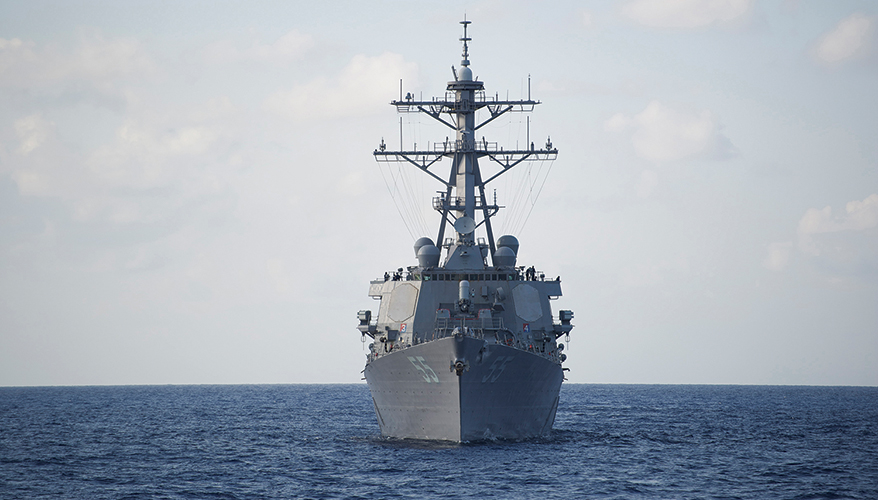Congress Delivers a ShipShape Allocation for Navy

Navy photo
On Dec. 23, Congress sent the National Defense Authorization Act to the president’s desk for signature. This sizable package, subsequently signed into law by President Joe Biden, totaled $858 billion.
Among all the provisions that were placed within the NDAA, one stands out as vital for U.S. national defense: the increase in ships allocated to the Navy in the coming years.
For years, voices across the political spectrum have criticized past armed service budgets that have not adequately corresponded to plans to grow the size of the naval fleet. However, the act is poised to meet the newly authorized requirement for ships.
This year, Congress remedied the ship shortfall by delivering appropriations that will facilitate fleet growth. For example, Congress allocated $32.6 billion for the purchase of new ships. This request hands the Navy a third, albeit unrequested, Arleigh Burke-class destroyer, a legally required floor of 31 amphibious vessels and prohibitions on retiring many of the ships that are currently in service.
The White House has not always approved of such inclusions. On July 12, the White House released a policy statement in which it explicitly stated that “the administration opposes establishing in statute a minimum number of Navy amphibious ships, or other numeric force structure provisions, as they unduly constrain evolutions in joint warfighting approaches and associated capability prioritization. Further, the administration strongly opposes incrementally funding a third Arleigh Burke-class destroyer in FY 2023.”
Despite this disagreement, which often reflects political differences concerning the structure of the nation’s armed forces, the increase in certain ship classes should be viewed as encouraging. This is especially true when viewed through a geopolitical lens focused on the nation’s No. 1 pacing challenge: China.
According to the Defense Department’s annual report on Chinese military power, Beijing is building increasingly modern surface combatants and expanding the size of its aircraft fleet so that it can expand its naval influence. Specifically, the Pentagon estimates that by the year 2025, China’s navy is expected to grow to 400 hulls.
The report further states that, “As of 2021, the People’s Liberation Army and Navy is largely composed of modern multi-role platforms featuring advanced anti-ship, anti-air, and anti-submarine weapons and sensors.”
The significance of this development is rooted in China’s aspiration to extend its sphere of influence and exert increasing levels of control over contested geographies in Asia.
According to the report, the “ability to perform missions beyond the First Island Chain is modest but growing as it gains more experience operating in distant waters and acquires larger and more advanced platforms.”
Furthermore, this flexibility decreases the requirement to build additional Chinese amphibious ships to successfully assault Taiwan. This operational flexibility also provides operational and logistics units within China’s marines the training and proficiency to move between military and civilian vessels not just in a Taiwan scenario, but in any maritime environment where civilian transport vessels are available and navy amphibious ships are not.
Unfortunately, this is not merely a theoretical proposition. The world has witnessed this expansionist attitude in recent years. In the South China Sea, China has claimed wide swaths of territory, constructed man-made islands, claimed vast natural resources and asserted a defensive posture against entities that question its claims of sovereignty.
Confrontations with Vietnam and the Philippines over maritime activity is an additional, and visible, example of Beijing’s strategy in practice.
By expanding influence in waters traditionally claimed by other sovereign nations, China has increased tensions and invited submissions of grievances before global arbitration bodies.
To counter this trend and protect the interests of U.S. allies in Asia, it is imperative that the United States keeps pace with China’s naval growth. This will not only ensure that the nation has the resources necessary to act as needed, but more importantly, this investment signals to its vast network of allies and partners that we are committed to preserving their security.
In 2023, the United States finds itself at a unique inflection point. Gone are the days of the post-Cold War unipolar moment. Instead, the nation finds itself in an increasingly contested and hostile global environment. To counteract such threats and preserve the interests and security of our allies, it is necessary to make the requisite investments required for establishing a strong defense apparatus.
The NDAA for 2023 contains a wide array of provisions that touch all parts of the U.S. Armed Forces. However, its commitment to sustaining and increasing its Navy remains of paramount importance. Not only does this Naval investment finally align U.S. strategic ends with the material means to match, but it will also ensure that the country is ready and able to defend its values and partners across the seas whenever a threat presents itself.
This deterring factor, which the National Defense Strategy heavily references, is an essential part of the U.S. defense ecosystem. The nation must be prepared to defend its global interests whenever necessary.
The 2023 NDAA’s investments towards a sizable, advanced and modern fleet will ensure that this can be achieved across the seas.
Chris Sax is a strategy associate at the National Defense Industrial Association.


Comments (0)